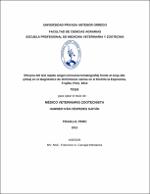| dc.contributor.advisor | Carvajal Mestanza, Francisco A. | |
| dc.contributor.author | Céspedes Gaitán, Hamner Iván | |
| dc.creator | Céspedes Gaitán, Hamner Iván | |
| dc.date.accessioned | 2015-10-07T17:25:25Z | |
| dc.date.available | 2015-10-07T17:25:25Z | |
| dc.date.issued | 2015 | |
| dc.identifier.uri | https://hdl.handle.net/20.500.12759/1149 | |
| dc.description.abstract | El objetivo de este estudio fue determinar la eficacia del Test Rápido Anigen (Inmunocromatografía) frente a la prueba Snap 4Dx (ELISA) en el diagnóstico de ehrlichiosis canina. Para ello se tomaron muestras sanguíneas de 20 canes domésticos, 12 hembras y 8 machos, de diferente edad y de 8 razas distintas.
Los resultados mostraron 11 casos positivos a ehrlichiosis y 4 negativos de acuerdo a la prueba de Snap 4Dx (ELISA); de ellos el 54,54% se encontraron en el rango de 1-4 años; en las hembras se halló el mayor porcentaje con el 63,63% del total de positivos. Por otro lado se obtuvieron 15 positivos según el Test Rápido Anigen (Inmunocromatografía) con 53.3% en la categoría 0 - ≤1 año, y 60% en las hembras; de los cuales se consideran 4 falsos positivos en comparación con la prueba de Snap 4 Dx. Para ambas pruebas, los variables sexo, edad y raza no fueron significativos.
La concordancia entre el Test Rápido Anigen (Inmunocromatografía) y el Snap 4Dx (ELISA) fue moderada. Para los caninos mayores a un año la concordancia es muy buena. En cuanto a la sensibilidad y especificidad del Test Rápido Anigen los resultados hallados fueron de 100% y 56% respectivamente, además de un valor predictivo positivo de 74% y negativo de 100%.
Se concluye que el Test Rápido Anigen (Inmunocromatografía) es menos eficaz que la prueba de Snap 4Dx (ELISA) en la población general de caninos. | es_PE |
| dc.description.abstract | The objetive of this study was to determine the effectiveness of the Quick
Test Anigen (Immunochromatography) vs. Snap 4Dx test (ELISA) for the
diagnosis of canine ehrlichiosis. For this blood samples from 20 domestic dogs,
12 females and 8 males of different age and 8 different races were taken.
The results showed 11 positive and 4 negative for ehrlichiosis cases
according to 4Dx Snap test (ELISA); 54.54% of them were in the range 1-4
years; in females with the highest percentage 63.63% of total positives are
found. On the other hand 15 positive were obtained according to the Quick Test
Anigen (Immunochromatography) with 53.3% in Category 0 - ≤1 year and 60%
in females; of which four are considered false positives compared to test Snap
4 Dx. For both tests, the sex, age and race were not significant.
The agreement between the Quick Test Anigen (Immunochromatography)
and the Snap 4Dx (ELISA) was moderate. For older dogs one year agreement
is very good. As for the sensitivity and specificity of those found Anigen Quick
Test results were 100% and 56% respectively, and a positive predictive value of
74% and 100% negative.
We conclude that Anigen Quick Test (Immunochromatography) is less effective
than 4Dx Snap test (ELISA) in the general population of canines. | en_US |
| dc.description.uri | Tesis | es_PE |
| dc.format | application/pdf | es_PE |
| dc.language.iso | spa | es_PE |
| dc.publisher | Universidad Privada Antenor Orrego - UPAO | es_PE |
| dc.rights | info:eu-repo/semantics/closedAccess | es_PE |
| dc.source | Universidad Privada Antenor Orrego | es_PE |
| dc.source | Repositorio Institucional - UPAO | es_PE |
| dc.subject | Inmunocromatografía | es_PE |
| dc.subject | SNAP 4Dx | es_PE |
| dc.subject | Ehrlichiosis canina | es_PE |
| dc.title | Eficacia del test rápido anigen (inmunocromatografía) frente al SNAP 4Dx (Elisa) en el diagnóstico de Ehrlichiosis canina en el Distrito la Esperanza, Trujillo, Perú. 2014 | es_PE |
| dc.type | info:eu-repo/semantics/bachelorThesis | es_PE |
| thesis.degree.level | Título Profesional | es_PE |
| thesis.degree.grantor | Universidad Privada Antenor Orrego. Facultad de Ciencias Agrarias | es_PE |
| thesis.degree.name | Médico Veterinario Zootecnista | es_PE |
| thesis.degree.discipline | Medicina Veterinaria y Zootecnia | es_PE |

